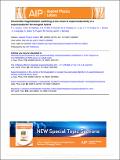Files in this item
Irreversible magnetization switching at the onset of superconductivity in a superconductor ferromagnet hybrid
Item metadata
| dc.contributor.author | Curran, P. J. | |
| dc.contributor.author | Kim, J. | |
| dc.contributor.author | Satchell, N. | |
| dc.contributor.author | Witt, J. D. S. | |
| dc.contributor.author | Burnell, G. | |
| dc.contributor.author | Flokstra, M. G. | |
| dc.contributor.author | Lee, S. L. | |
| dc.contributor.author | Cooper, J. F. K. | |
| dc.contributor.author | Kinane, C. J. | |
| dc.contributor.author | Langridge, S. | |
| dc.contributor.author | Isidori, A. | |
| dc.contributor.author | Pugach, N. | |
| dc.contributor.author | Eschrig, M. | |
| dc.contributor.author | Bending, S. J. | |
| dc.date.accessioned | 2016-02-05T16:10:11Z | |
| dc.date.available | 2016-02-05T16:10:11Z | |
| dc.date.issued | 2015-12-30 | |
| dc.identifier | 240626023 | |
| dc.identifier | 4ae8d111-2025-448a-b3b7-164ffe8eb0e1 | |
| dc.identifier | 85032070443 | |
| dc.identifier | 000368442300028 | |
| dc.identifier.citation | Curran , P J , Kim , J , Satchell , N , Witt , J D S , Burnell , G , Flokstra , M G , Lee , S L , Cooper , J F K , Kinane , C J , Langridge , S , Isidori , A , Pugach , N , Eschrig , M & Bending , S J 2015 , ' Irreversible magnetization switching at the onset of superconductivity in a superconductor ferromagnet hybrid ' , Applied Physics Letters , vol. 107 , no. 26 , 262602 . https://doi.org/10.1063/1.4938467 | en |
| dc.identifier.issn | 0003-6951 | |
| dc.identifier.other | ORCID: /0000-0002-2020-3310/work/54995376 | |
| dc.identifier.other | ORCID: /0000-0002-4333-1358/work/59953704 | |
| dc.identifier.uri | https://hdl.handle.net/10023/8158 | |
| dc.description | The authors acknowledge financial support from: EPSRC in the UK under Grant Nos. EP/G036101/1, EP/J010626/1, EP/J010634/1, EP/J01060X/1; The NanoSC COST Action MP-1201; A JEOL Europe studentship under Grant No. EP/I000933/1, plus support from the STFC ISIS neutron and muon source. Finally, from RFBR in Russia under 15-52-10045_Ko-a. | en |
| dc.description.abstract | We demonstrate that the magnetic state of a superconducting spin valve, that is normally controlled with an external magnetic field, can also be manipulated by varying the temperature which increases the functionality and flexibility of such structures as switching elements. In this case, switching is driven by changes in the magnetostatic energy due to spontaneous Meissner screening currents forming in the superconductor below the critical temperature. Our scanning Hall probe measurements also reveal vortex-mediated pinning of the ferromagnetic domain structure due to the pinning of quantized stray fields in the adjacent superconductor. The ability to use temperature as well as magnetic field to control the local magnetisation structure raises the prospect of potential applications in magnetic memory devices. | |
| dc.format.extent | 5 | |
| dc.format.extent | 1771094 | |
| dc.language.iso | eng | |
| dc.relation.ispartof | Applied Physics Letters | en |
| dc.subject | Physics and Astronomy (miscellaneous) | en |
| dc.subject | NDAS | en |
| dc.title | Irreversible magnetization switching at the onset of superconductivity in a superconductor ferromagnet hybrid | en |
| dc.type | Journal article | en |
| dc.contributor.sponsor | EPSRC | en |
| dc.contributor.institution | University of St Andrews. School of Physics and Astronomy | en |
| dc.contributor.institution | University of St Andrews. Condensed Matter Physics | en |
| dc.identifier.doi | https://doi.org/10.1063/1.4938467 | |
| dc.description.status | Peer reviewed | en |
| dc.identifier.grantnumber | EP/J01060X/1 | en |
This item appears in the following Collection(s)
Items in the St Andrews Research Repository are protected by copyright, with all rights reserved, unless otherwise indicated.

